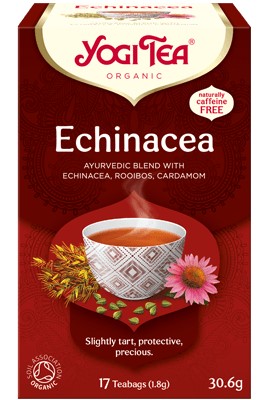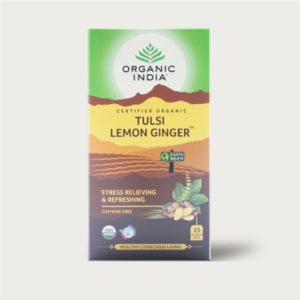Yogi Tea – Organic Echinacea 17 Teabags
R100.06
Yogi Tea Echinacea is a delicious-intensive spice and herbal tea mixture that enchants.
Out of stock
Description
The Tart-tangy Echinacea, combined with sweet herbs like fennel, ginger and cardamom warm the senses, and make this tea a balanced Ayurvedic taste experience.
The essence of this tea is: “I am protected”.
Ingredients
Cinnamon*, echinacea*, ginger*, fennel*, rooibos*, roasted chicory*, carob*, cardamom*, basil*, burdock root*, black pepper*, turmeric root*, astragalus*, vanilla beans*
*Organic
Brewing Suggestions
Pour 250 ml of freshly boiled water over the teabag. Allow to infuse for 5 minutes or longer for a stronger flavour.
More about Yogi Tea Echinacea blend ingredients
Echinacea
Echinacea is a plant that grows wild in North America and has long been valued by Native Americans. It attains a height of 90 cm and has purple leaves. Echinacea tastes slightly sweetish and tart-spicy.
Rooibos
To this day, the redbush – which is also called rooibos – from the legume family is cultivated exclusively in the cedar mountains of South Africa. Growing to a height of two metres, the plant is only harvested once every year. Its leaves are made into rooibos tea, which is the mild-fruity and slightly sweet tasting national beverage of South Africa.
Cardamom
Cardamom has been one of the most popular spices for thousands of years throughout the entire Asian and Arabian area. Its subtle, sweetish-spicy aroma predestines cardamom for use in many different foods ranging from sharp curries to spicy Christmas biscuits.
Cinnamon
Cinnamon is among the most expensive spices in the world and was supposedly already used as a spice in China in 3,000 B.C. Cinnamon is extracted from the bark of the South-Asian cinnamon tree. It has an aromatic-sweetish taste and contains valuable essential oils.
Ginger
Whether in the Christmas biscuits, as a curry mixture or in lemonade: The bulbous ginger is among the best-known spice plants in the world. For thousands of years, it has been cultivated in the tropical heat of eastern Asia. It gives many of our YOGI TEA®s a fruity-hot and aromatically spicy taste.
Fennel
Fennel belongs to the umbellifer family and has been popular for thousands of years around the globe due to its intensive aroma. It originally came from the Mediterranean region. Its sweetish-spicy taste is slightly reminiscent of anise.
Chicory (roasted)
The chicory is also known under the name of blueweed because its sky-blue flowers prefer to grow at the wayside. The flowers of the plant from the asteraceae family, which is native to Europe, northwestern Africa and western Asia, open for just one single day. Its roots taste spicy-tart and give herbal tea mixtures a touch of coffee taste – but without the caffeine.
Carob
Indigenous to the Mediterranean area and Asia, carob is a plant from the legume family. The long, brown fruit of the carob tree – which grows up to a height of 18 metres – taste sweetish and carry seeds that each weigh precisely 0.197 grams. Due to this special characteristic of nature, carob seeds were used as the measuring unit for diamonds in antiquity.
Basil
This “royal plant”, as the Ancient Greeks called basil, came to northern Europe in the 12th century. It has a wonderfully spicy aroma, which is ideally featured in both Mediterranean cuisine and freshly brewed tea.
Turmeric root
Turmeric primarily grows in Asia and the Mediterranean region. It belongs to the ginger family and is one of the main components of curry powder. In India, the ginger-like and slightly savoury curcuma root was already one of the most important spices more than 5,000 years ago. It was even considered to be sacred.
Burdock root
The burdock is a plant of the asteraceae family. It grows at the edges of the forests and on the fields. The roots of the burdock are gathered in the autumn of the first growth year and taste semi-sweet.
Black pepper
Also called the “king of spices,” black pepper is one of the world’s most important spices in addition to salt. It originally came from the Indian Malabar Coast and tastes intensive-spicy, ranging from slightly spicy to quite spicy.
Astragalus
The plant called astragalus in the West is known in China under the name of Huang Qi. The literal translation means the “Yellow Emperor” and accordingly reflects the significance of the plant for human beings.
Vanilla beans
The “queen of spices” is among the most popular aromas in the world. It belongs to the orchidaceae family and is native to Mexico and Central America. Its subtle taste and elaborate processing make the genuine vanilla an especially precious spice plant.
The contents of the Knysna Health website shall not be regarded as medical advice, or a basis from which to make medical decisions. The use of information found on this site is completely your responsibility and at your own risk. Our recommendation is that if you have health concerns that you feel unsure about how to deal with, that you contact your trusted health professional for personalized advice.




